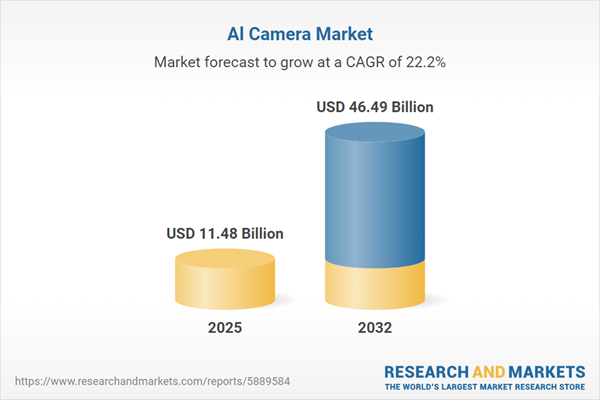Speak directly to the analyst to clarify any post sales queries you may have.
The AI camera market is rapidly transforming global security, analytics, and consumer experiences, prompting organizations across sectors to reassess their strategies as artificial intelligence capabilities converge with imaging innovation.
Market Snapshot: Unprecedented Growth for AI Camera Market
The AI camera market grew from USD 9.38 billion in 2024 to USD 11.48 billion in 2025, advancing at a CAGR of 22.15%. This upward momentum is forecasted to accelerate, with the sector expected to reach USD 46.49 billion by 2032. This surge is powered by advances in neural network processing, stronger demands for machine vision in both enterprise and consumer domains, and evolving regulatory requirements.
Scope & Segmentation of the AI Camera Ecosystem
- Product Types: 360 degree cameras, fisheye cameras, network cameras (wired, wireless), PTZ cameras (indoor, outdoor)
- Applications: Automotive (ADAS, autonomous driving), retail analytics, smart home, surveillance (public safety, traffic monitoring)
- End Users: Banking financial services, government, residential, retail, transportation
- Resolution Tiers: Below 2MP, 2-5MP, above 5MP
- Distribution Channels: Offline, online
- Regional Coverage: Americas (including North and Latin America), Europe, Middle East & Africa, Asia-Pacific
- Key Players: Hangzhou Hikvision Digital Technology Co., Ltd, Zhejiang Dahua Technology Co., Ltd, Axis Communications AB, Hanwha Techwin Co., Ltd, Robert Bosch GmbH, Panasonic Corporation, Sony Group Corporation, Avigilon Corporation, Teledyne FLIR LLC, VIVOTEK Inc
Key Takeaways: Strategic Insights for Senior Decision-Makers
- AI camera adoption is driven by breakthroughs in edge computing and neural processing, facilitating real-time image interpretation in security and analytics applications.
- Integration with smart home systems, retail insights, and intelligent transportation networks supports a shift from traditional surveillance to holistic operational analytics relevant across sectors.
- End users, from government to retail and automotive, are prioritizing modular hardware and interoperable software that reduce total cost of ownership and speed up customization.
- Vendors are leveraging partnerships, targeted acquisitions, and cross-industry collaborations, supporting continuous innovation in both hardware and analytics capabilities.
- As models for image classification and behavior prediction grow more advanced, the distinction between observation and automated response is increasingly blurred, requiring updated risk and compliance strategies.
- Regional regulations, infrastructure maturity, and consumer expectations mean that tailored go-to-market strategies and localized product adjustments are vital to maximize growth potential.
Tariff Impact: Navigating Global Supply Chain Adjustments
Forthcoming changes to United States tariff policies in 2025 are set to reshape supply chain and pricing frameworks across the AI camera sector. Elevated duties on core raw materials and components may affect manufacturing costs, prompting many organizations to diversify sourcing, explore alternative manufacturing regions, and streamline product design. These shifts could yield more resilient regional supply ecosystems and drive innovation as companies consolidate critical components to mitigate duty exposure and optimize assembly processes.
Methodology & Data Sources for AI Camera Market Research
This report’s findings are based on an integrated approach, combining in-depth executive interviews with analysis of company filings, patent literature, and sector publications. Quantitative insights are aggregated from shipment data, procurement records, and industry-wide datasets, with triangulation applied to validate trends and supply chain shifts.
Why This Report Matters
- Provides actionable intelligence for executives seeking to align product roadmaps with evolving regulatory landscapes, customer requirements, and regional opportunities.
- Enables confident supply chain planning with coverage of tariff impacts, sourcing shifts, and component integration strategies tailored to market volatility.
- Supports investment prioritization by highlighting segment-specific growth, best-practice partnerships, and innovations in imaging analytics and system design.
Conclusion
The AI camera market is defined by accelerating innovation, increasing complexity, and heightened regional differentiation. Stakeholders equipped with this analysis are well positioned to anticipate industry shifts, optimize investments, and achieve market leadership in the evolving AI imaging landscape.
Additional Product Information:
- Purchase of this report includes 1 year online access with quarterly updates.
- This report can be updated on request. Please contact our Customer Experience team using the Ask a Question widget on our website.
Table of Contents
3. Executive Summary
4. Market Overview
7. Cumulative Impact of Artificial Intelligence 2025
Companies Mentioned
The companies profiled in this Al Camera market report include:- Hangzhou Hikvision Digital Technology Co., Ltd
- Zhejiang Dahua Technology Co., Ltd
- Axis Communications AB
- Hanwha Techwin Co., Ltd
- Robert Bosch GmbH
- Panasonic Corporation
- Sony Group Corporation
- Avigilon Corporation
- Teledyne FLIR LLC
- VIVOTEK Inc
Table Information
| Report Attribute | Details |
|---|---|
| No. of Pages | 180 |
| Published | October 2025 |
| Forecast Period | 2025 - 2032 |
| Estimated Market Value ( USD | $ 11.48 Billion |
| Forecasted Market Value ( USD | $ 46.49 Billion |
| Compound Annual Growth Rate | 22.1% |
| Regions Covered | Global |
| No. of Companies Mentioned | 11 |









